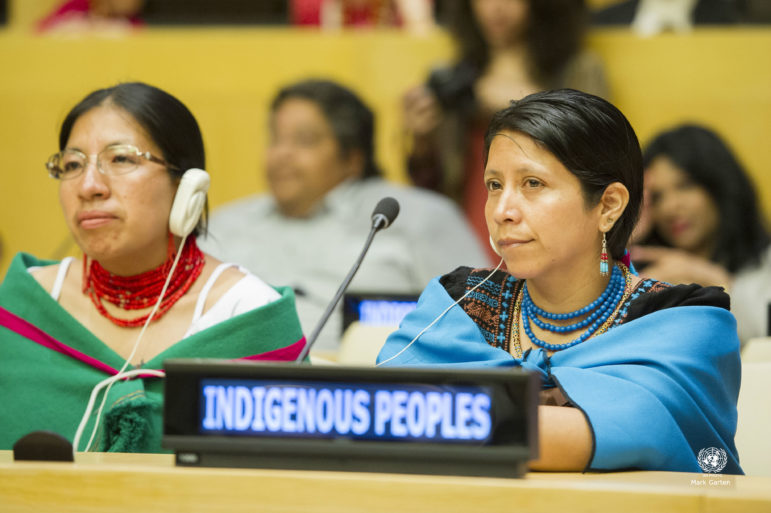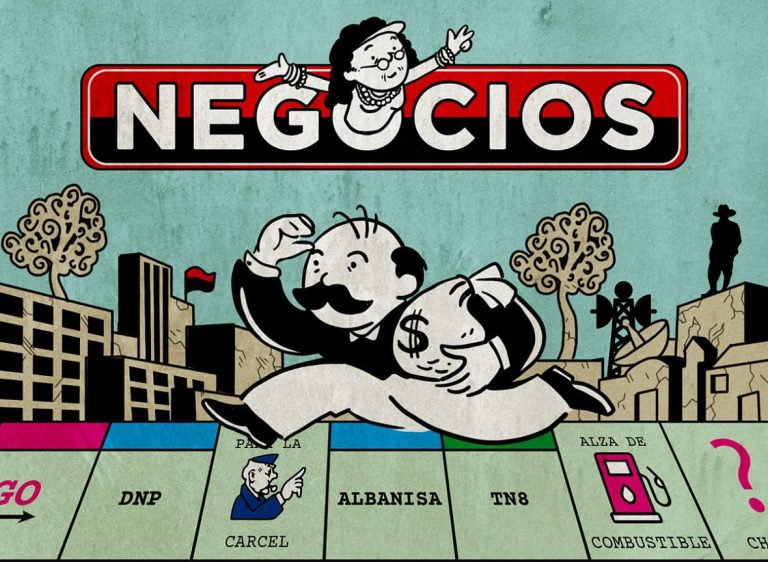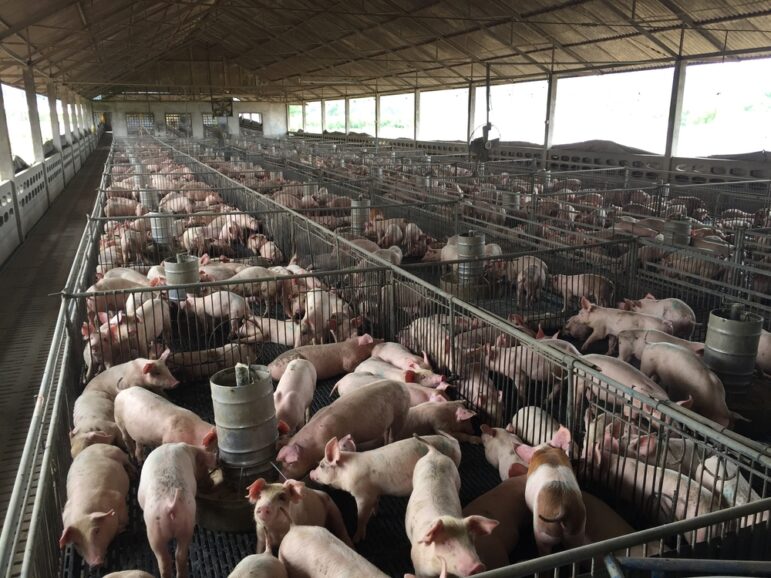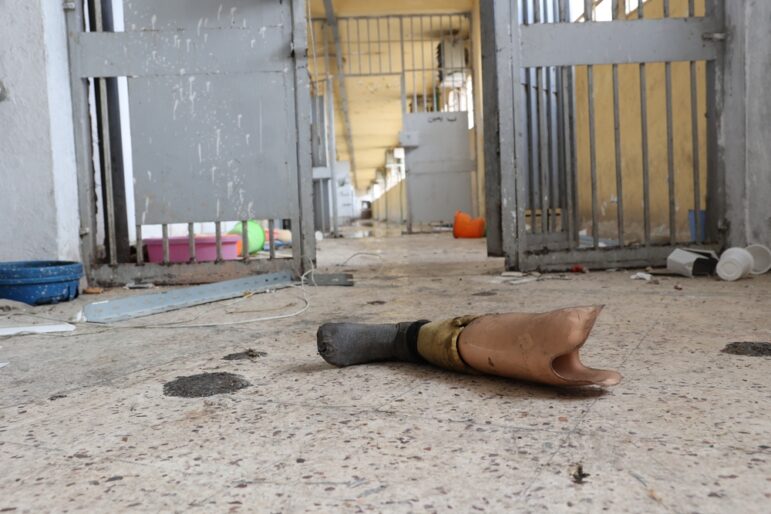

The historical Navajo county court house in Holbrook, Arizona. Signmage: Shutterstock
Guide Resource
GIJN/NAJA Guide for Indigenous Investigative Journalists
Chapter Guide Resource
Data Journalism on Indigenous Communities
Chapter Guide Resource
Land Ownership: Community Rights Under Threat
Chapter Guide Resource
Investigating Criminal Justice
Chapter Guide Resource
Exposing Exploitation and Corruption
Chapter Guide Resource
Covering the Climate Crisis
Chapter Guide Resource
Investigating Murdered or Missing Persons
Chapter Guide Resource
Indigenous Data Sovereignty
Chapter Guide Resource
Getting Documents, Dealing with Whistleblowers, and Staying Safe
Chapter Guide Resource
GIJC23 Indigenous Investigations Webinar
In early 2019, the United Nations Special Rapporteur on Indigenous Peoples expressed serious concerns about the systems of justice for Indigenous persons, announcing plans to write a thematic report and inviting public input.
In her call for comments, Victoria Tauli Corpuz cited these “main concerns”:
- The lack of effective recognition of, and support for, their systems of justice by local, regional, and national level authorities.
- Ongoing discriminatory and prejudicial attitudes against Indigenous peoples and their systems of justice.
- The lack of effective methods of coordination between their justice systems and the State ordinary justice authorities.
She intends to address these issues “through an examination of international standards regarding Indigenous customary justice, access to justice, and the right to a fair trial, as well as lessons learned from domestic legislation and judicial decisions addressing Indigenous customary justice, as well as observations and recommendations made by international human rights bodies.”
Corpuz’s outline could well be a guide for investigative journalists. (See versions in French, Spanish, English.)
She posed 17 questions and, while many are designed to gather basic information, some could be fodder for journalistic inquiry, such as:
- What are the main challenges faced by Indigenous people in accessing the ordinary justice system?
- Describe how legal aid and the right to interpretation are provided in the ordinary justice system for Indigenous victims, witnesses, and those accused of having committed a crime.
This GIJN/NAJA guide is designed to suggest avenues for investigating criminal justice systems.

Photo: Shutterstock
Investigating the Process and Underlying Causes
Although stories about singular crimes play out daily in the media, it is rarer to see examinations of systemic problems within the criminal justice system.
In fact, the potential breadth of the topic can seem daunting from a holistic standpoint.
Authors Chris Cunneen, with the Jumbunna Institute for Indigenous Education and Research at the University of Technology Sydney, and Juan Marcellus Tauri, with the Faculty of Arts and Social Sciences at the University of Waikato, New Zealand, looked at Indigenous people’s interactions with criminal justice systems in Australia, New Zealand, Canada, and the US. They concluded that “little will change to reduce the negative nature of Indigenous/criminal justice interactions until the settler-colonial state and the discipline of criminology show a willingness to support Indigenous peoples’ desire for self-determination and for leadership in the response to the social harms that impact their communities,” they concluded. Tauri is from the Ngāti Porou Māori tribe.
Asked whether this doesn’t set a high bar for journalism, Cunneen replied, “It seems to me there is a great deal of effective work that investigative journalism can do!”
There are many potential topics to cover.
Disproportionate Convictions
Perhaps the most common stories in the media about Indigenous people and the criminal justice system describe disproportionate rates of arrest and imprisonment, drawing largely upon official sources.
Indigenous people comprised 4.1% of Canada’s population in 2016-17, but were 27% of the federal prison population, according to a 2019 Statistics Canada report. The rate of incarceration for women is going up faster than that of men.
APTN Investigates: Indigenous People in Canada Behind Bars was a 2017 exploration of this expansive topic by Cullen Crozier for the Aboriginal Peoples Television Network (APTN).
Similar data appears in Australia.
“Aboriginal and Torres Strait Islander people comprise just 2% of the national population,” wrote lawyer Shahleena Musk, a Larrakia, in a 2018 @indigneousX article. “Yet 28% of the population behind bars are Aboriginal and Torres Strait Islander, and this national shame is only set to worsen,” he said. “Rather than merely focusing on punishment, our criminal justice systems need to be geared to assisting people.”
Describing and explaining these differences remains a continuing task.
A related topic to be explored is the impact of social media hate speech on violence against Indigenous peoples. A 2017 study in Australia found that some Facebook group users “are able to name and shame the racialized outsiders who not only allegedly commit crimes, but who are defined as morally unworthy, as a racial group.”
The article by Chris Cunneen and Sophia Russell in the Oxford Research Encyclopedia of Criminology and Criminal Justice concludes, “While in some cases there appears to be a direct link between the Facebook groups and incidents of violence, at a broader level, it is the constant reinforcement of an environment of racist violence that is the most troubling.”
Findings Facts, Data Gaps
Data exist on many aspects of the criminal justice system that may provide inspiration and evidence.
Crime statistics are largely maintained by federal governments, but they may also be found in lower-level jurisdictions. However, inadequate data on Indigenous populations is a frequent barrier. These gaps may themselves be a worthwhile subject for exploration. See this guide’s chapter on data journalism.
In the US, for example, law enforcement agencies failed to notify the FBI about nearly half of the homicides of American Indians and Alaskan Natives committed from 1999-2017, according to a 2019 study by the nonprofit Murder Accountability Project (MAP), started Thomas Hargrove, a former investigative journalist.
A 2019 investigation by Oregon Public Broadcasting’s KUOW, Booked and Buried, found that 306 people died in the last 10 years after being sent to local jails. The reporters were Conrad Wilson, Tony Schick, Austin Jenkins, and Sydney Brownstone. This article was one in a series and they also created a public database.
“Incomplete data tracking hides a crisis of rising death rates in overburdened Northwest jails that have been set up to fail the inmates they are tasked with keeping safe,” the Book and Buried article states.
In 2018, Guardian Australia built the searchable database, Deaths Inside, which tracks every known Indigenous death in custody in every jurisdiction from 2008 to 2019. See a description of how the project was done.
Problems with data-gathering, a dry but important topic, are buried in works such as the US government report Tribal Crime Data-Collection Activities, 2019. The report describes problems including “that many tribes do not have the capability or technology to transmit records to national systems, either through their own infrastructure or the states’.” In addition, some tribes have not converted their manual records to electronic versions.
Multiple Data Points
There are many potential stories to tell with data and personal stories. Below find some key topics.
Arrests and prosecution:
- Arrest rates
- Types of charges leveled
- Prosecution of hate crimes
- Composition of juries
- Assigned sentence lengths
Incarceration:
- Security classifications
- Prison medical records
- Suicide rates
- Deaths in custody
- The role of private-sector prison operators
Parole and post-incarceration:
- Served sentence lengths
- Parole rates
- Rates of suspension or revocation of parole
- Recidivism
Reporting Examples
Official records may yield some great facts and stories, but the hunt typically requires more digging.
Crime statistics have been interrogated for information, as discussed in this 2018 In These Times article by Stephanie Woodard describing an analysis of government records by the Center on Juvenile and Criminal Justice, which demonstrated higher rates of police killings of Native Americans.
She noted, “The Washington Post and the Guardian (UK) have both developed databases to fill in the gaps, but even these sometimes misidentify or omit Native victims.”
Another large data-gathering effort was done to see whether small communities in Alaska, including Indigenous communities, employed a police officer. Kyle Hopkins of Anchorage Daily News and Alex Mierjeski of ProPublica put the question to more than 500 organizations representing 195 communities. Of that number, 70 communities reported having no police at some point in 2019, they explained in an article about the project.
In another story, Hopkins reported that at least 14 cities in Alaska have employed police officers whose criminal records should have prevented them from being hired under state law.
His reporting drew reactions from Native American leaders.
“It’s outrageous that we have a situation where we have such a lack of public safety that communities are resorting to hiring people who have the propensity for violence,” said Melanie Bahnke, a board member for the Alaska Federation of Natives, which represents 191 tribes, and a tribal member of the Native Village of Savoong.
A joint investigation by The Associated Press and the University of Maryland’s Capital News Service learned that many US jails failed to stop inmate suicides.
Reporters Sharon Cohen and Nora Eckert found that “scores of jails have been sued or investigated in recent years for allegedly refusing inmates medication, ignoring their cries for help, failing to monitor them despite warnings they might harm themselves, or imposing such harsh conditions that the sick got sicker.”
Getting there required months of “examining hundreds of cases in local news reports, reviewing investigations of specific jails, and compiling a database of more than 400 lawsuits filed in the last five years over alleged mistreatment of inmates, most of whom were mentally ill,” according to the story.

Photo: Pexels
Finding Sources
Two Indigenous journalists who cover the criminal justice system and Indigenous peoples in North America spoke at a 2019 conference of Investigative Reporters & Editors (IRE) with ideas of how best to make contacts.
Records are important, according to Associated Press law enforcement reporter and former NAJA President Mary Hudetz, “but the most efficient and authentic route to finding stories in Native communities is still going to come from people.” This and other advice is included in Hudetz’s tipsheet.
Hudetz (Crow) suggested finding contacts at police departments and also reaching out to community members. “… Because they’re the ones feeling the impact of government gaps and missteps,” she said.
She said places to find sources include local Native American centers, tribal colleges on reservations, lectures by a Native American student alliances, and colleagues at local or tribal newspapers.
Also speaking at IRE was Mi’kmaq Trina Roache, a video journalist who works on APTN Investigates, a documentary series on Aboriginal Peoples Television Network.
“Indigenous people living these stories will be your best source,” Roache stressed,
She suggested contacting Indigenous organizations because they often have a person working on a criminal justice portfolio. Her tipsheet recommends looking at court records and talking to Indigenous lawyers.
Their tipsheets also provide suggestions for finding sources, experts, statistics, and documents.
Root Causes
To look at the reasons behind high incarceration rates for Indigenous people, wider research is necessary. For this, check out experts in many fields and review academic research.
This avenue may require looking for other statistics: on health, housing, unemployment, education levels, dysfunctional families and communities, and inequality. This point is made on the website of the Aboriginal Justice Forum (AJF) in Australia.
Potential underlying problems were cited by Chief Tribal Judge Stacie Smith from the Fort Peck Reservation in Montana, quoted in a Billings Gazette article, Native American Homicide Rates are Soaring, but Causes Aren’t Clear Due to Inconsistent Data, by Sam Wilson and Mike Kordenbrock.
Smith listed causes including: historical trauma and a disintegration of traditional values, domestic violence, unemployment, drug and alcohol addiction, the adjacent Bakken oil fields, a general lack of resources, and an unwillingness by the federal government to help tackle more than one problem at a time.
Articles on the periodic official release of data, like this one in The Star (Canada), often are accompanied by interviews trying to explain causes and describe possible solutions but that is usually as far as reporting goes.
Looking for Specific Problems
Specific elements of the criminal justice system may provide fodder for investigation.
Looking at the underlying data may help to discover the sources of systemic bias, but other sources may also provide ideas.
Court cases about specific complaints may also expose a systemic problem.
For example, in June 2019 a Supreme Court of Canada decision said the Correctional Service of Canada had failed to prove that the risk assessment tests it uses for deciding on penitentiary placement, parole eligibility, and parole conditions are not culturally biased against Indigenous prisoners.
Articles by criminal lawyers may be a source for ideas, too.
Jonathan Rudin, Program Director at Aboriginal Legal Services in Canada, wrote The (In)justice System and Indigenous Peoples in Policy Options (2018), in which he suggested reforms. These reforms included more use of what are referred to as Gladue reports, which are prepared by writers working for Indigenous organizations and provide information on the backgrounds of the offenders who are being sentenced and suggest alternatives to incarceration where possible.
Follow specialized publications for ideas.
National Magazine, the official periodical of the Canadian Bar Association, covers criminal justice. Canada’s Prisons are Failing by Justin Ling (2019) alleges that “deteriorating conditions are at a crisis point.”
The Crime Report is a comprehensive online US publication from the Center on Media, Crime and Justice at the John Jay College of Criminal Justice in New York.
On the academic side, there are publications such as The Australia & New Zealand Journal of Criminology.
Solutions Investigations
Solutions that are proposed to fix problems also warrant examination.
Justice Reform and The Revival of Indigenous Justice in Canada and the United States, a 2018 column in First Outcomes by Catherine Bargen, provides an overview of restorative justice, which emphasizes accountability and making amends between victims, offenders, and other persons.
She points out that the concept “owes more than a debt of gratitude to Indigenous justice worldview and practices,” and provides examples of its use in the US and Canada.
A 2018 article by Australian academics Sophie Russell and Chris Cunneen explores the government’s failure to engage in “justice reinvestment,” a strategy for reducing the number of people in prison by investing funds drawn from the corrections budget into early intervention, prevention, and diversionary solutions in communities where many prisoners come from and return to.
‘Cultural Healing’ and the Search for Justice in Tribal Lands, by Eric Killelea, which appeared in the Hibbing Daily Tribune (Minnesota) in 2019, addresses the potential creation of a “Wellness Court,” tailored to the needs of Native Americans.
A probe by APTN’s Trina Roache in 2018 found that some Canadian jails weren’t doing an adequate job of providing access to Indigenous spiritual services and programming.
Official Reports Have Value
Reports by official commissions may be excellent sources for background and context.
They are one way to learn about the pertinent laws and administrative processes, which can be complex.
In the US, for example, tribal courts have broad criminal jurisdiction. But a US Supreme Court decision limits the ability of Native American nations to try and punish non-Indians. For details see the General Guide to Criminal Jurisdiction in Indian Country by Tribal Court Clearinghouse.
The Violence Against Women Act (VAWA) reauthorization of 2013 included a provision that affirmed sovereign authority of tribal governments to exercise criminal jurisdiction over certain non-Indians who violate qualifying protection orders or commit domestic or dating violence against Indian victims on tribal lands. The act’s last renewal failed and efforts at restoring it are ongoing.
See a description by the National Congress of American Indians (NCAI) and NAJA’s VAWA reporting guide.
Government Reports
Below find an illustrative list of recent reports:
United States
Australia
- Pathways to Justice: Inquiry into the Incarceration Rate of Aboriginal and Torres Strait Islander Peoples (2018), from the Australian Law Reform Commission
- Royal Commission into the Detention and Protection of Children in the Northern Territory (2017)
Canada
- National Inquiry into Missing and Murdered Indigenous Women and Girls (2019): Includes policy recommendations, including how to investigate cold cases.
Governmental Sources
United States
- Bureau of Justice Statistics — Indian Country Justice Statistics. Recent reports have included Tribal Crime Data-Collection Activities, 2019 and Survey of Jails in Indian Country.
- The National Institute of Justice issued a report in 2016 examining the prevalence of violence against American-Indian and Alaska-Native women and men (Summary).
Australia
- Australian Bureau of Statistics: The data covers national Indigenous population statistics, social conditions, prisoners, corrections system, health, employment, and social conditions. For example, see Corrective Services, Australia, March quarter 2019.
- Australian Institute of Criminology: Data includes deaths in custody, juveniles in detention, drug use among offenders, homicide, law and order, and community safety. One recent report: Indigenous Deaths in Custody: 25 years Since the Royal Commission into Aboriginal Deaths in Custody.
Canada
- Statistics Canada is the primary national data agency. It publishes data and reports such as this one from 2019: Adult and Youth Correctional Statistics in Canada, 2016/2017.
- Office of the Correctional Investigator serves as an Ombudsman for federal offenders and prepares detailed annual reports. Look also for testimony, such as that given about Indigenous women in prison before the House of Commons Standing Committee on Women. The website displays a list of relevant news stories.
- Canada’s Department of Justice posts some basic information on Indigenous peoples and the criminal justice system.
- Study on the Human Rights of Federally-Sentenced Persons: The Most Basic Human Right is to be Treated as a Human Being is a 2016 report by the Senate Standing Committee on Human Rights. See also a 2018 interim report on the same subject.
Nongovernmental Resources
Here is a sampling of available resources:
United States
- Tribal Law and Policy Institute, a Native-American-operated nonprofit, is “dedicated to providing free publication resources, comprehensive training, and technical assistance for Native nations and tribal justice systems in pursuit of our vision to empower Native communities to create and control their own institutions for the benefit of all community members, now, and for future generations.” The Institute supports Tribal Law Clearinghouse, which has many resources, including a good list of related organizations.
- Indian Law Resource Center has resources as part of the Safe Women, Strong Nations project. See the article Ending Violence Against Native Women.
- NCAI: See a page on Public Safety and Justice.
- Understanding Crime and Justice Statistics — A Reporter’s Guide: This guide is available for sale from IRE.
- Justice Research and Statistics Association: Although aimed at academic researchers, this site has some valuable factsheets, such as Using State Criminal History Records for Research and Evaluation, Web Scraping, and Implicit Racial Bias. Also see lists of related organizations and specialized online resources.
- Crime & Justice Research Alliance: Particularly see its Expert Directory and Explore Our Research pages.
Australia
- Indigenous Justice Clearinghouse: A searchable collection of Indigenous justice resources for Australia and New Zealand. The library includes a wide range of Research and Evaluations (including published papers, reports, and books). The Datasets page includes key datasets relevant to Indigenous justice. The Programs and Projects page profiles useful examples of “what works” to address Indigenous over-representation in prison and keep communities safe. Finally, the Research Centres page lists includes expertise in Indigenous justice research and policy. The clearinghouse is a collaborative partnership between the Australian Institute of Criminology and the Council of Attorneys-General.
- Change the Record advocates for criminal justice reforms and keeps track of relevant reports and news.
- Creative Spirits, an independent website, has a page on Aboriginal prison rates.
New Zealand
- JustSpeak is a movement of young people who are speaking out on criminal justice.
Canada
- Indigenous People and the Criminal Justice System: A Practitioner’s Handbook, by Jonathan Rudin, “is a comprehensive guide to the challenges and considerations that arise from working with Indigenous persons in the criminal law context,” according to a 2018 review.
- The John Howard Society has research papers and links to other organizations.

















